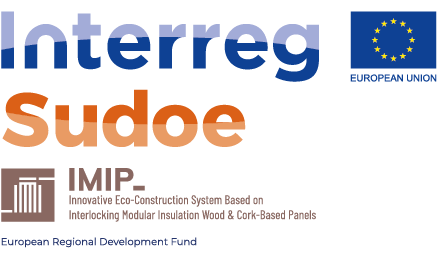The aim of WP1 “Integral design of the sustainable construction system value chain” was to identify and characterize all actors involved in sustainable construction systems with a "value chain" perspective. For this purpose five deliverables were produced with information collected by ISA from Portugal, FCBA from France and UPV, INIA and AITIM from Spain. They can be access in the official web page (http://www.sudoe-imip.eu/results/).
The South-West Region of the EU, located between the Mediterranean Sea and the Atlantic Ocean, comprises Spain and Portugal and the regions of the South-West of France. It contains an estimated 39 million hectares of forestland and is characterized by highly diverse bioclimatic features and vegetation types. The forests area achieves in Spain, France and Portugal, respectively, 18.6 million 17.3 million, and 3.3 million of hectares. Trees, mainly species from the genera Pinus and Quercus, dominate around 71% of the forest typesand 21% are dominated by shrub formations. The conifer species, which have the greatest presence, are the Aleppo pine (Pinus halepensis Mill.), Maritime pine (P. pinaster Mill.), Scots pine (P. sylvestris L.) and Black pine (P. nigraArnold). Oaks (Quercus) also play a relevant role in France, and in the Iberian Peninsula with Quercus suber.
Forest management certification intends to assure that forests are sustainably and responsibly managed. In Spain, Portugal and France two operating international schemes provide Forest management certification: The Forest Stewardship Council (FSC) and the Program for the Endorsement of Forest Certification (PEFC). Spain has 2.3 million ha of certified forest, representing around 12% of the forest area in the country where 2,641 companies are certified in Chain of Custody. Portugal has more than 0.8 million ha of certified forest, representing around 15.5% of the forest area in the country where 2,261 companies are certified in Chain of Custody. France has 8.2 million ha of certified forest, representing around 50% of the forest area in the country where 1,514 companies are certified in Chain of Custody.
The forest-based sector value chains produce a wide range of products ranging from wood construction products, packaging, furniture, paper and pulp products, and hygiene articles to biomass fuels, bioplastics, biocomposites, carbon fibres, textile fibres and biochemical.
Sawn wood industry holds the largest production of Maritime pine sawn wood with a mean annual sawn timber volume of 3.0 million m3. The forestry sector employed around 395.32 thousand full-time jobs in 2010, about half of them worked in the manufacture of wood. There are about 642 companies operating in the cork industry in Portugal and employ around 8,305 workers. The cork industry in Spain provides more than 2,000 full-time jobs at more than 98 cork processing and production companies. Portugal is the world leader of the cork sector in terms of exports. It had a market share of 62.4%, followed by Spain with 18.5% and France with 5.1%. Total world exports in 2017 were 1,578.2 million euros (Portugal 985.2 million euros and Spain 292.9 million euros). Besides the use of cork as a so-called “natural solid” material, as for the natural cork stoppers, other cork-based materials are produced, namely cork agglomerates and expanded corkboards. The expanded cork agglomerates are used as insulation materials mainly for thermal, acoustic and vibrational applications. Manufacture of cork products for building industry, the agglomerates for coverings correspond to 17% (10 million m2) of the total number of cork products and expanded agglomerated cork 6% (150000 m3) of the total number of cork products.
The set of criteria and indicators that will be used to evaluate the sustainability of the IMIP eco-construction system were identified. They were grouped into categories to evaluate their contribution to climate change mitigation and adaptation, to human health and safety, creation of employment, sustainable management of natural resources, dependence on non-renewable resources, and ensuring food security.
Work in this WP also assessed the minimum technical requirements and its environmental features while providing guidelines for these features for the selection and use of possible raw materials for the project panels according to project objectives and good technical practices.
